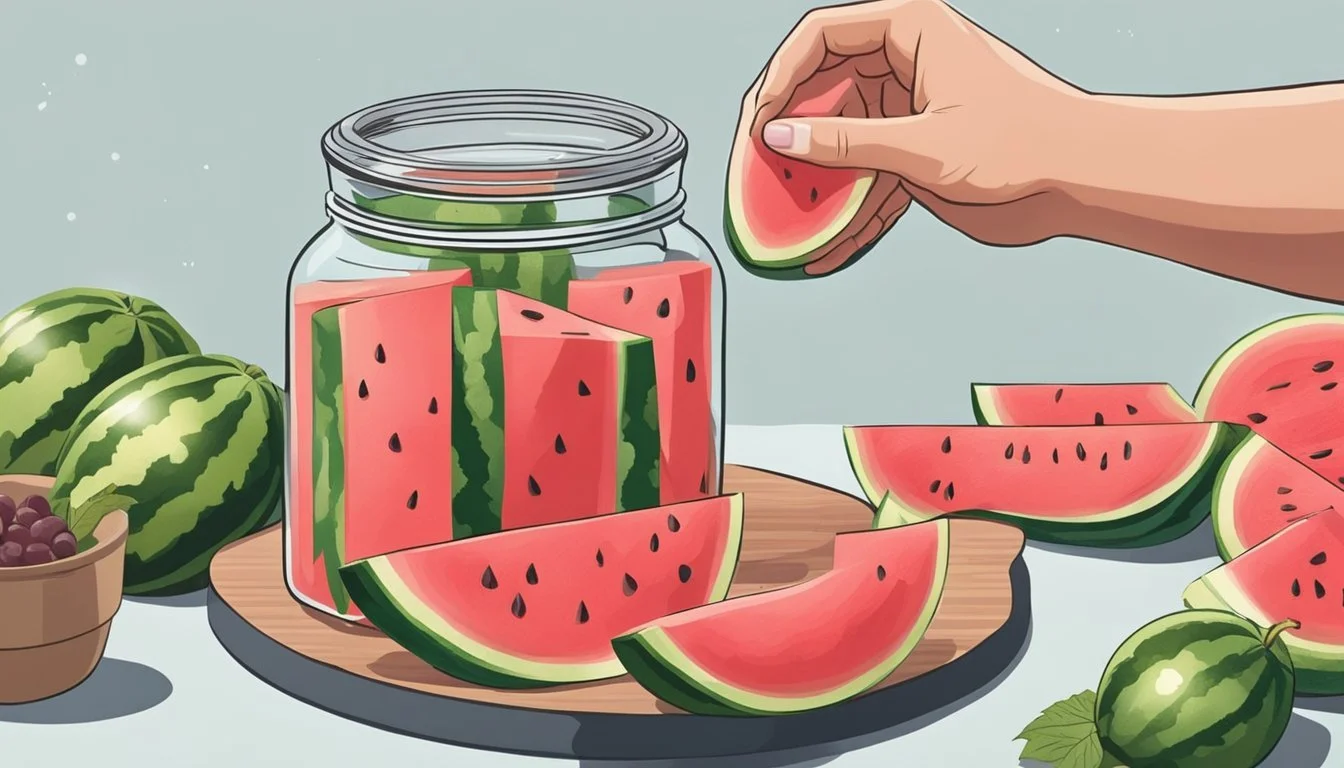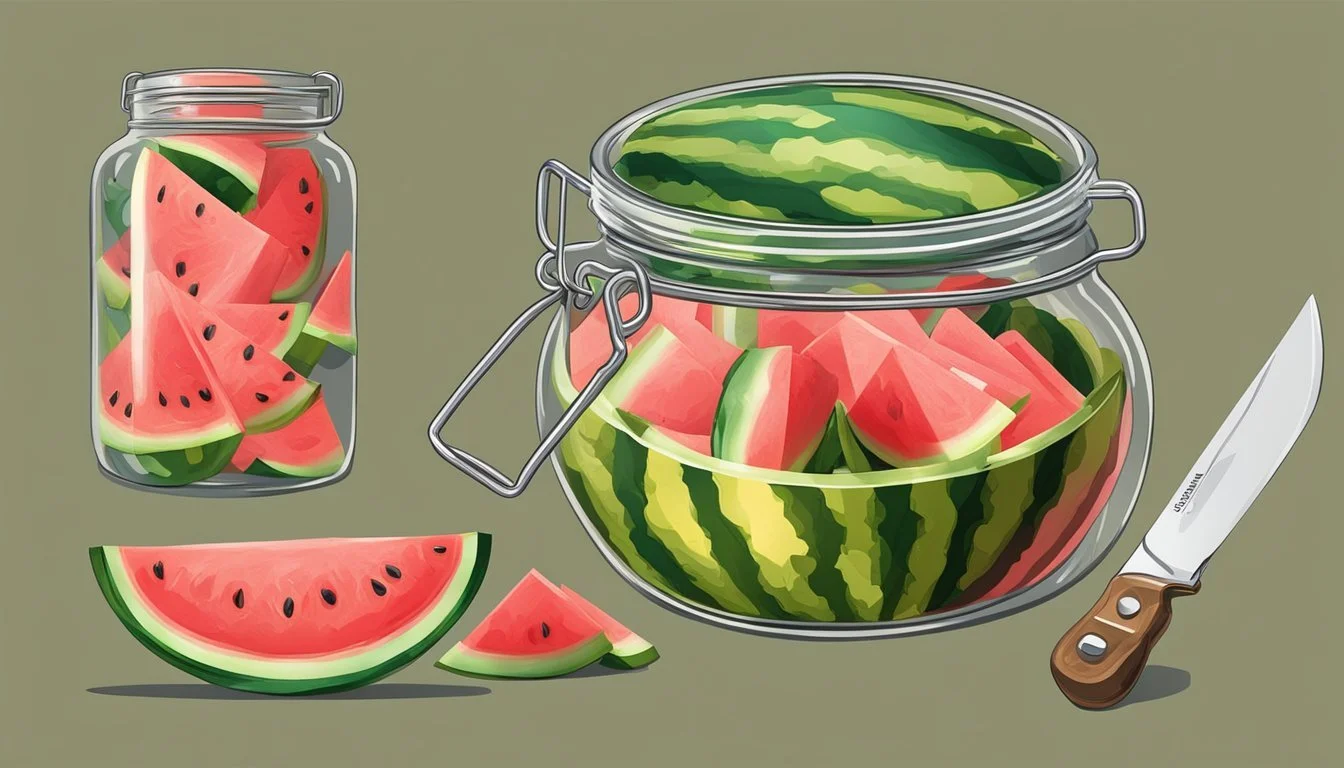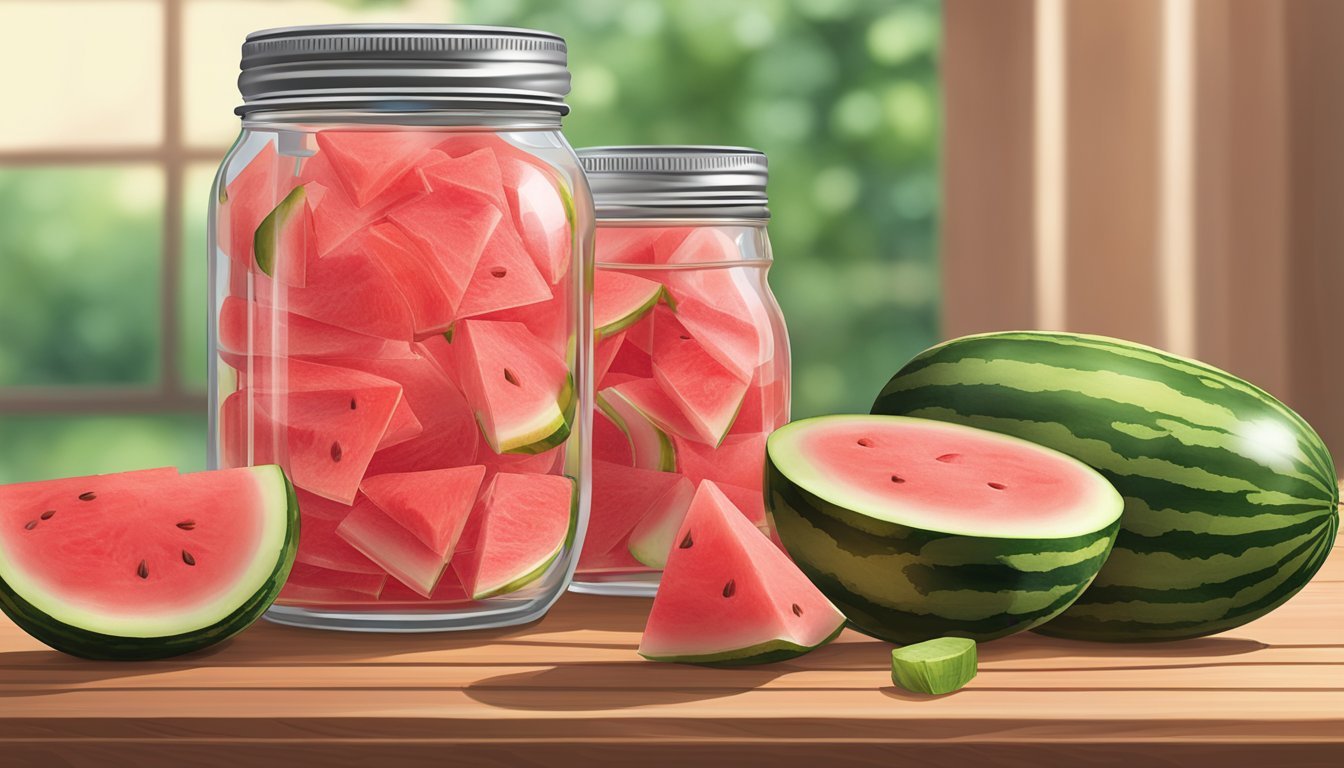Watermelon Rind Pickles
A Sweet, Crunchy Snack with Tangy Flair
Watermelon rind pickles offer a delightful twist on traditional pickling, utilizing a part of the fruit that is often discarded. This sweet and crunchy snack has its roots in old-fashioned culinary traditions, marrying the refreshing taste of watermelon with a tangy brine. As eco-consciousness rises, the art of pickling watermelon rinds is experiencing a resurgence, highlighting a low-waste approach to cooking while delivering an unexpected taste sensation.
The process of creating watermelon rind pickles isn't just about sustainability; it's an exercise in patience and precision. The transformation from hard, white rinds to translucent, tender morsels involves a meticulous method of simmering the rinds in a mixture of vinegar, sugar, and spices. The result is a snack that is as crunchy as it is flavorful, providing a unique addition to any appetizer spread or picnic basket.
While often categorized as a treat from yesteryear, watermelon rind pickles are far from outdated. Modern takes on the recipe often incorporate contemporary flavors like vanilla or jalapeño, signalling that this snack is adaptable and ripe for innovation. They are more than a mere curiosity — watermelon rind pickles represent both the preservation of historical food practices and the ongoing evolution of snacking preferences.
Tracing the Tradition
Watermelon rind pickles are a delightful remnant from the days of resourceful Southern cooking, where not a single part of the watermelon went to waste. The tradition of these pickles dates back to a time when summer's bounty was preserved in any way possible, and watermelon rind pickles became a staple in many households.
One of the seminal texts that references this practice is "What Mrs. Fisher Knows About Old Southern Cooking", where Abby Fisher, a freed slave, shared her culinary wisdom with the world. This cookbook included a variety of recipes using watermelon rind, showcasing its versatility in the kitchen.
The process of creating these old-fashioned pickles begins in summer, when watermelons are most abundant. Families would gather to prepare the rind, often transforming it into a sweet, crunchy snack to be enjoyed well beyond the season. The rind, typically discarded, was given a second life through pickling, becoming a celebration of frugality and flavor.
Typical steps involved in crafting these pickles included:
Peeling and cubing the watermelon rind
Soaking in a brining solution, often with added ice for crispness
Boiling the rind until tender
Mixing with a variety of spices and vinegar
Canning for preservation
It's worth noting that the recipes have varied slightly through the years, but the essence of this old-fashioned treat remains the same—a sweet, tangy pickle with a hint of crunch. Watermelon rind pickles are not just a snack; they are a testament to the ingenuity and tradition of Southern cuisine.
Health Benefits
Watermelon rind pickles are not just a tasty snack; they also offer notable health benefits. One such benefit is their fiber content. Fiber is essential for digestive health, and incorporating watermelon rind into the diet can contribute to the needed daily intake.
These pickles are also low in calories, making them a suitable option for those monitoring calorie intake. By opting for food that is satisfying yet calorie-conscious, one can enjoy flavorful snacks (What wine goes well with snacks?) without compromising dietary goals.
The watermelon rind is a source of nutrients that support overall health. It provides vitamin A and vitamin C, which are vital for maintaining a robust immune system, and includes an amino acid named citrulline, known for its potential to improve blood circulation and reduce blood pressure.
Furthermore, watermelon rind pickles epitomize the plant-based snacking alternative. Plant-based diets are linked with various health benefits, and by utilizing parts of the watermelon that are typically discarded, these pickles encourage a reduction in food waste.
Nutrient Benefit Fiber Supports digestive health. Vitamins A & C Promote a healthy immune system. Citrulline May enhance blood circulation.
In summary, watermelon rind pickles offer a unique combination of being a health-conscious, plant-based snack that taps into the nutritional benefits of what would otherwise be waste, aligning with sustainable food practices and enhancing dietary variety.
Selecting the Right Watermelon
In the craft of pickling watermelon rind, choosing a high-quality watermelon is critical. The perfect watermelon leads to flavorful, crunchy preserves that can be enjoyed as a sweet and tangy snack.
Identifying the Best Watermelons
A prime watermelon for pickling should have a thick and firm rind, a necessity for maintaining the pickle's texture. They should be hefty for their size, indicating juicy, dense flesh and a thicker rind, which is desirable for pickling. The skin should exhibit a deep green color without any soft spots or bruises. Stripes on the skin complemented by a creamy yellow spot where the melon rested on the ground are hallmarks of a ripe watermelon. Ripe watermelons also emit a hollow sound when tapped indicating the right degree of firmness and hydration in the red flesh, which also means the rind is at peak condition for pickling.
Preparing the Watermelon Rind
Once a suitable watermelon is selected, preparation of the rind is straightforward. First, the red flesh should be carefully sliced away from the rind so it can be saved for consumption or other recipes, ensuring not to waste the edible portion. The thin green outer skin should be removed, leaving a layer of white rind which will be pickled. This layer is sliced into uniform pieces, which then can be further processed through a brining or pickling method to develop their flavor and signature crunch. Rind prepared from the correct watermelon will endure the pickling process and emerge with the ideal balance of sweet and tart notes.
Ingredients and Tools
Creating watermelon rind pickles requires a careful selection of ingredients and the appropriate tools. Precision in both can yield a delightful, crunchy snack.
Key Ingredients
Sugar: Often granulated sugar is used to add sweetness to the brine.
Salt: Essential for flavor balance, one typically uses regular table salt.
Vinegar: White vinegar is a common choice for its clear color and sharp taste.
Water: Necessary for preparing the pickling brine.
Spices: Typically, spices such as cinnamon, cloves, and sometimes star anise or allspice berries are included for depth of flavor.
Required Tools
Glass Jars: Sterilized glass jars are crucial for storing and preserving pickles.
Canning Pot: A large pot suitable for a water bath to process the jars.
Jar Lifter: A tool to safely transfer hot jars in and out of boiling water.
Canning Funnel: Helps in cleanly transferring the brine into jars without spillage.
Tight-fitting Lids and Rings: Necessary to create an airtight seal to preserve the pickles.
The Pickling Process
The meticulous craft of pickling transforms the often-discarded watermelon rind into a deliciously sweet and crunchy snack. Each step, from brine preparation to final storage, ensures the rinds become flavorful pickles.
Creating the Brine
The brine is the essence of the pickling process, infusing the rinds with flavor and preserving them. It typically consists of a mixture of vinegar, water, sugar, and salt. Heated until the sugar and salt thoroughly dissolve, this solution can also include spices like cinnamon, cloves, and allspice to add complexity to the pickles' taste.
Preparing the Rind
Preparation begins with removing the pink flesh and outer green skin of the watermelon, leaving only the white rind behind. The rind should then be cut into bite-sized pieces. It's crucial that these pieces are consistent in size to ensure even pickling.
Combining Ingredients
In this stage, the rinds are often pre-soaked in a brine solution before the final pickling. Sometimes, aromatics like lemon slices or vanilla might be added for additional flavor layers. The rind pieces are placed into clean mason jars, ready to be submerged in the hot brining liquid.
Cooking and Simmering
The seasoned brine and rind pieces are combined in a suitable pan, such as a stainless steel saucepan. The contents are brought to a boil and then simmered until the rinds become tender and translucent.
Canning and Storing
The tenderized rinds along with the hot brine are packed into sterilized jars, ensuring a ½-inch headspace remains. After removing any air bubbles and wiping the rims clean, lids and rings are applied to the jars. The filled jars are then processed in a water bath canner for a set amount of time, typically around 10 minutes, to seal and preserve. Once cooled, the jars are stored in a cool, dark pantry or can be kept in a refrigerator to extend shelf life.
Serving Suggestions
Watermelon rind pickles offer a delightful balance of sweet and tangy flavors, making them perfect for enhancing a variety of dishes. They can be enjoyed as a standalone snack or integrated as a vibrant component in culinary creations.
Pairing with Foods
Watermelon rind pickles, with their crisp texture and robust flavor, make an excellent accompaniment to an array of foods:
Salads: They add a crunchy, sweet contrast when diced and sprinkled over leafy greens.
Sandwiches: Incorporating sliced watermelon rind pickles into sandwiches delivers a delightful zing that complements both meats and cheeses.
Salsa: Chopped finely, they can invigorate a fresh salsa, offering a unique twist to the classic condiment.
Snack Board: Serving them alongside crackers and a variety of cheeses provides a satisfying snack option.
Incorporating into Recipes
These pickles transcend their role as a mere condiment, providing an inventive ingredient for chefs and home cooks:
Salad Dressings: Blended into dressings, watermelon rind pickles impart a unique sweet and tangy flavor profile.
Charcuterie (What wine goes well with charcuterie?) Boards: Infuse a touch of sweetness into a charcuterie board by adding them to the selection, enriching the palate.
Cooked Dishes: Chopped pickles can be stirred into grain dishes or used as a garnish, offering a contrast in both taste and texture.
Incorporating watermelon rind pickles into dishes extends beyond the mere hint of sweetness; their presence elevates the layers of flavor.
Recipe Variations
When crafting watermelon rind pickles, cooks can easily adjust the sweetness and spices or experiment with different vinegars and spices to create a range of flavors, from sweet to tangy to spicy.
Adjusting Sweetness and Spices
To modify the sweetness of watermelon rind pickles, the sugar content can be increased for a sweeter taste or decreased for a less sugary snack. Consider using brown sugar for a deeper flavor profile. Spices offer another avenue for customization; for a spicier kick, jalapeños can be sliced and added to the pickling mixture. Traditional pickling spices such as cloves and allspice berries will impart a classic flavor, while peppercorns add a peppery note to the pickles. It is essential to taste and adjust the spices according to personal preference.
Less Sweet: Reduce the amount of sugar in the recipe.
More Sweet: Add more sugar or substitute with brown sugar.
Spicy Variant: Include sliced jalapeños or increase peppercorns.
Classic Spices: Utilize cloves and allspice for a traditional taste.
Alternative Vinegars and Spices
Varying the type of vinegar can significantly change the flavor of watermelon rind pickles. Apple cider vinegar provides a fruity and tangy taste, while rice vinegar will offer a milder tang. Introducing soy sauce to the pickling liquid can provide an umami flavor and unique twist to the recipe. Experimenting with different vinegars and adding aromatic spices like star anise and cinnamon can result in a complex flavor palette. Always ensure the use of pickling salt to maintain the proper texture and pickling action.
Apple Cider Vinegar: Introduces a fruity tang.
Rice Vinegar: Gives a milder tang, ideal for those preferring a less assertive flavor.
Soy Sauce: Adds a touch of umami when used judiciously.
Pickling Salt: Essential for proper pickling and texture preservation.
Tips and Tricks
When making watermelon rind pickles, certain techniques can ensure the best texture and taste, as well as proper preservation. These tips and tricks can help one achieve crisp, flavorful pickles that have an extended shelf life.
Ensuring Crunchiness
To maintain a crunchy texture, one must handle the rinds with care from the initial cutting to the final processing. Watermelon rinds should be cut into uniform shapes to ensure even cooking. Overcooking can lead to tender, not crunchy, pickles; therefore, one should simmer the rinds just until they start to become translucent. A crisp bite can be aided by adding calcium chloride, otherwise known as pickle crisp, into the brining solution.
Maximizing Flavor
Flavor infusion is critical to creating delicious watermelon rind pickles. One should use a balanced mixture of vinegar, sugar, and spices such as ginger, cinnamon, cloves, or even a hint of vanilla to enhance the sweet profile. Fresh ingredients significantly impact the flavor depth of the pickles. For a complex flavor profile, one can experiment with different types of vinegar or add aromatic spices during the pickling process.
Shelf Life and Storage
After packing the rinds into sterilized jars and sealing them with lids and rings, processing the jars in a water bath canner is essential for long shelf life. To avoid spoilage, one must ensure that the jars have been processed for the correct amount of time, usually around 10 minutes, and are sealed correctly. Store the pickles in a cool, dark place like a fridge, where they can last several months. Opened jars should be kept in the fridge to maintain the pickles' crunchiness and prevent them from becoming tender over time.
Social Media and Trends
In the world of homemade preserves and pickles, social media has become a crucial platform for sharing recipes, and watermelon rind pickles are trending. Let's explore how this traditional treat is gaining renewed popularity online.
Sharing on Social Networks
On Instagram, images of homemade watermelon rind pickles are often shared with hashtags like #watermelonrindpickles and #homemadepickles, sparking interest and engagement from food enthusiasts. These visually-driven platforms serve as a digital cookbook, where step-by-step recipes and vibrant photos guide and inspire users to try their hand at pickling.
Facebook groups dedicated to canning and pickling are communities where users post questions, share success stories, and offer tips for pickling watermelon rinds. Here, members can react to content with likes and comments, fostering a sense of camaraderie and shared learning.
Pinterest is an essential tool for collectors of pickling recipes, including those for watermelon rind pickles. Pinners can find a plethora of pickling methods with detailed ingredient lists and procedural instructions, neatly organized in boards for later reference.
Current Trends in Pickling
The art of pickling is experiencing a resurgence, with watermelon rind pickles enjoying popularity for their balance of sweet and tangy flavors. Users often cite their nostalgic quality and pleasant texture as reasons for their choice in making and consuming them.
The trend is reflected in the growing number of pickling recipes optimized for both taste and health benefits. Many social media posts discuss the zero-waste aspect of using watermelon rinds, which aligns with sustainable lifestyle movements that have been gaining traction.
Moreover, social media influencers are known to experiment with global flavors, infusing traditional watermelon rind pickles with spices and ingredients from various cuisines. Such innovations are shared and spread quickly across networks, influencing others to expand their own pickling horizons.





